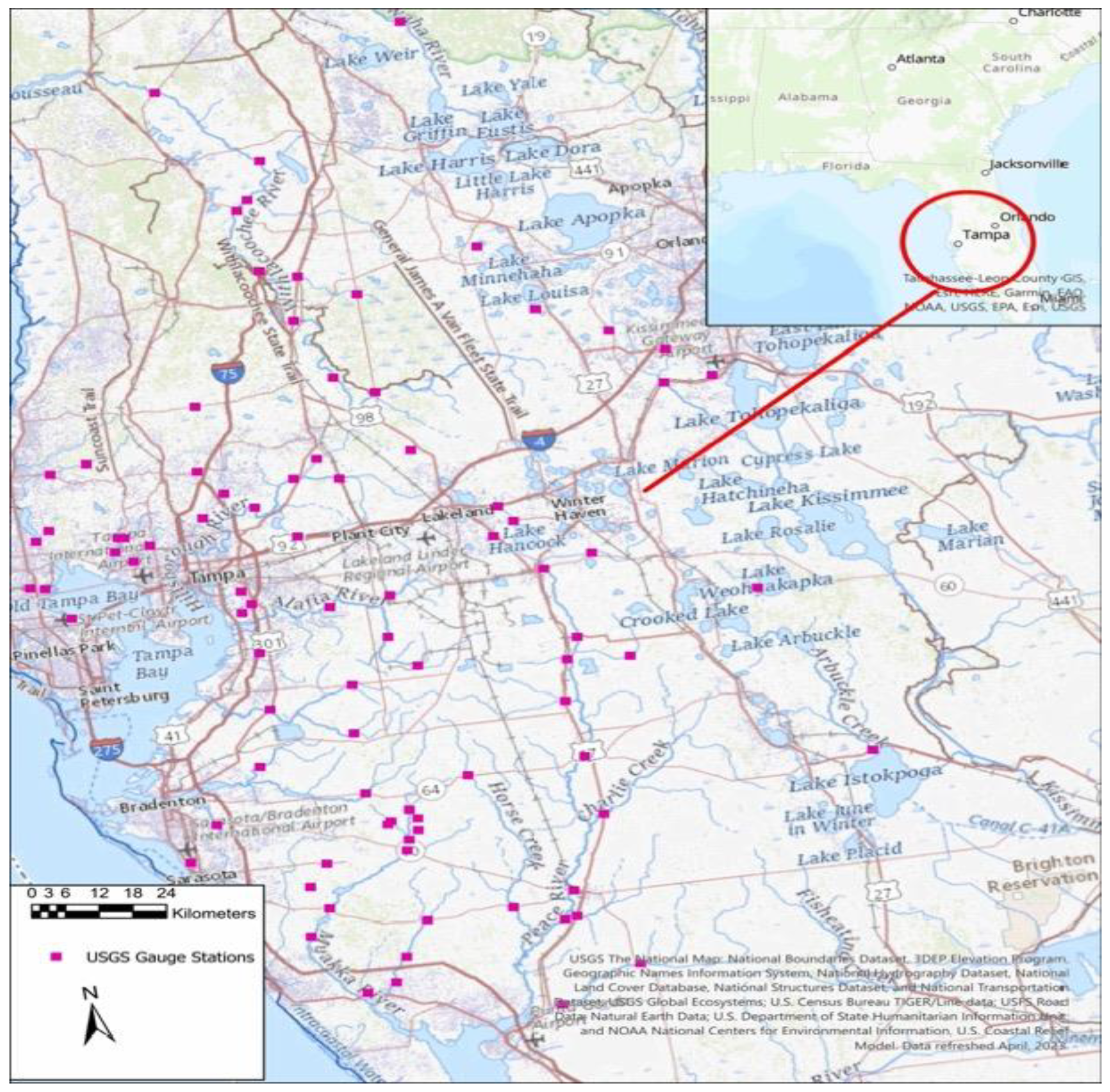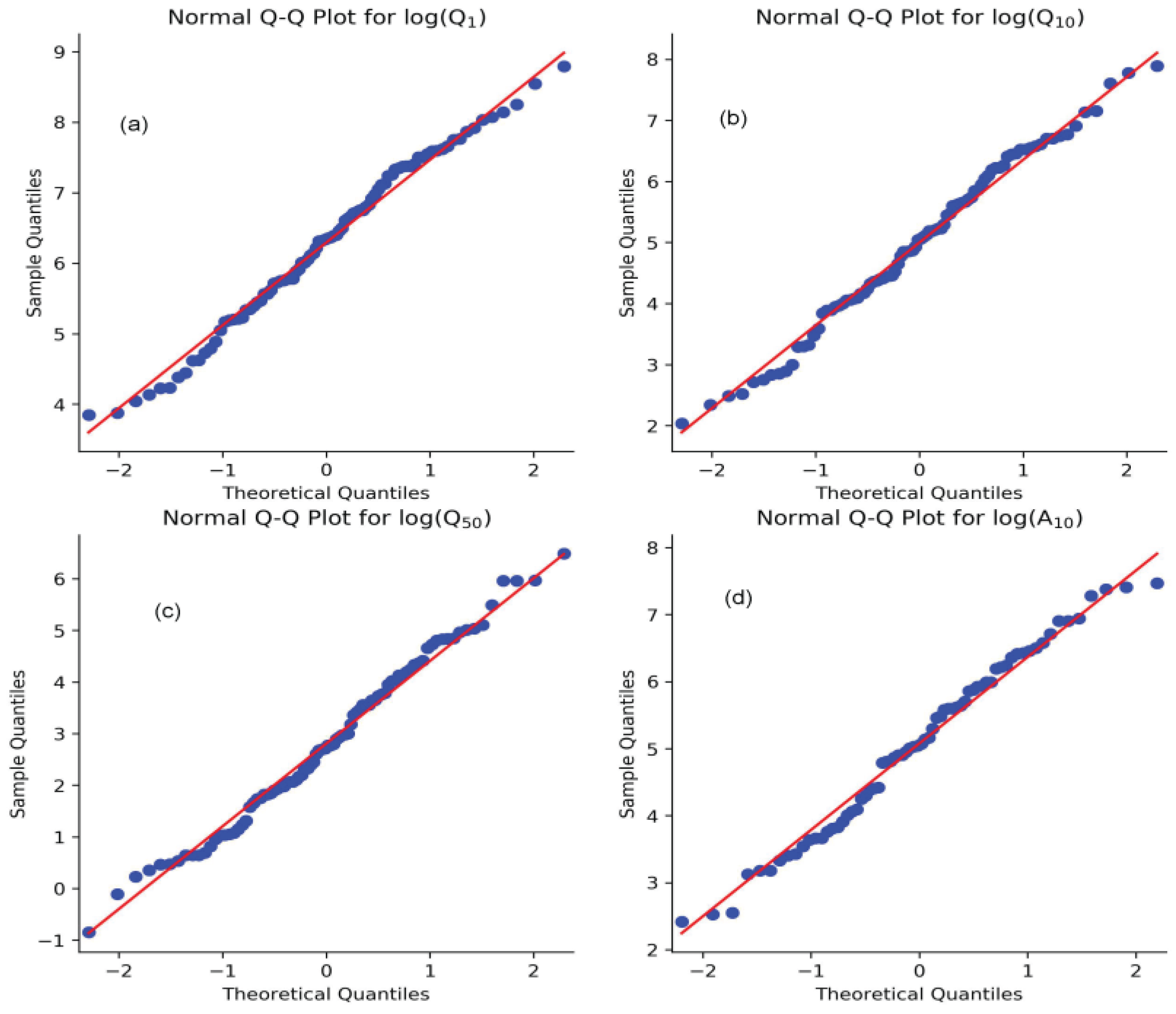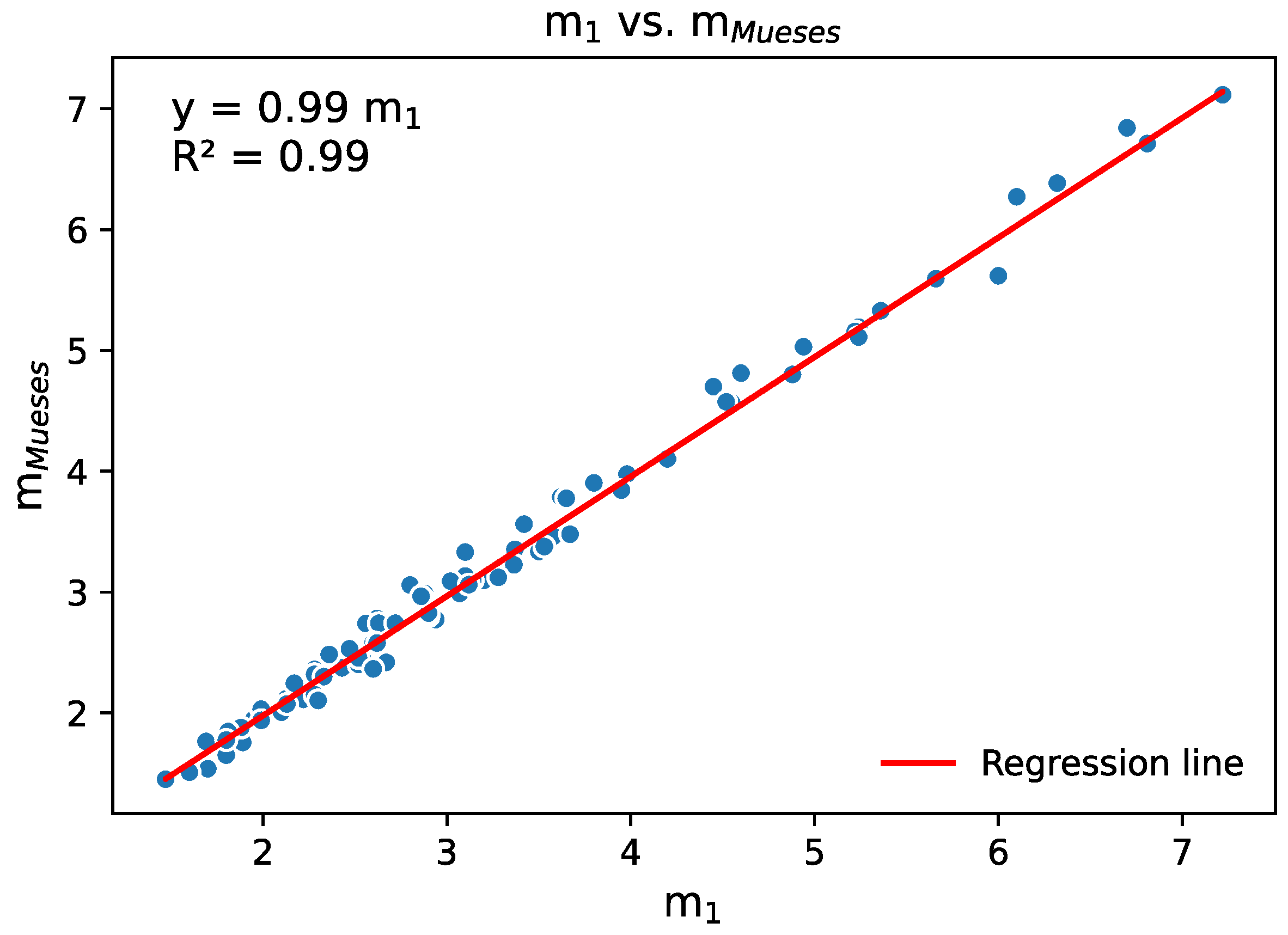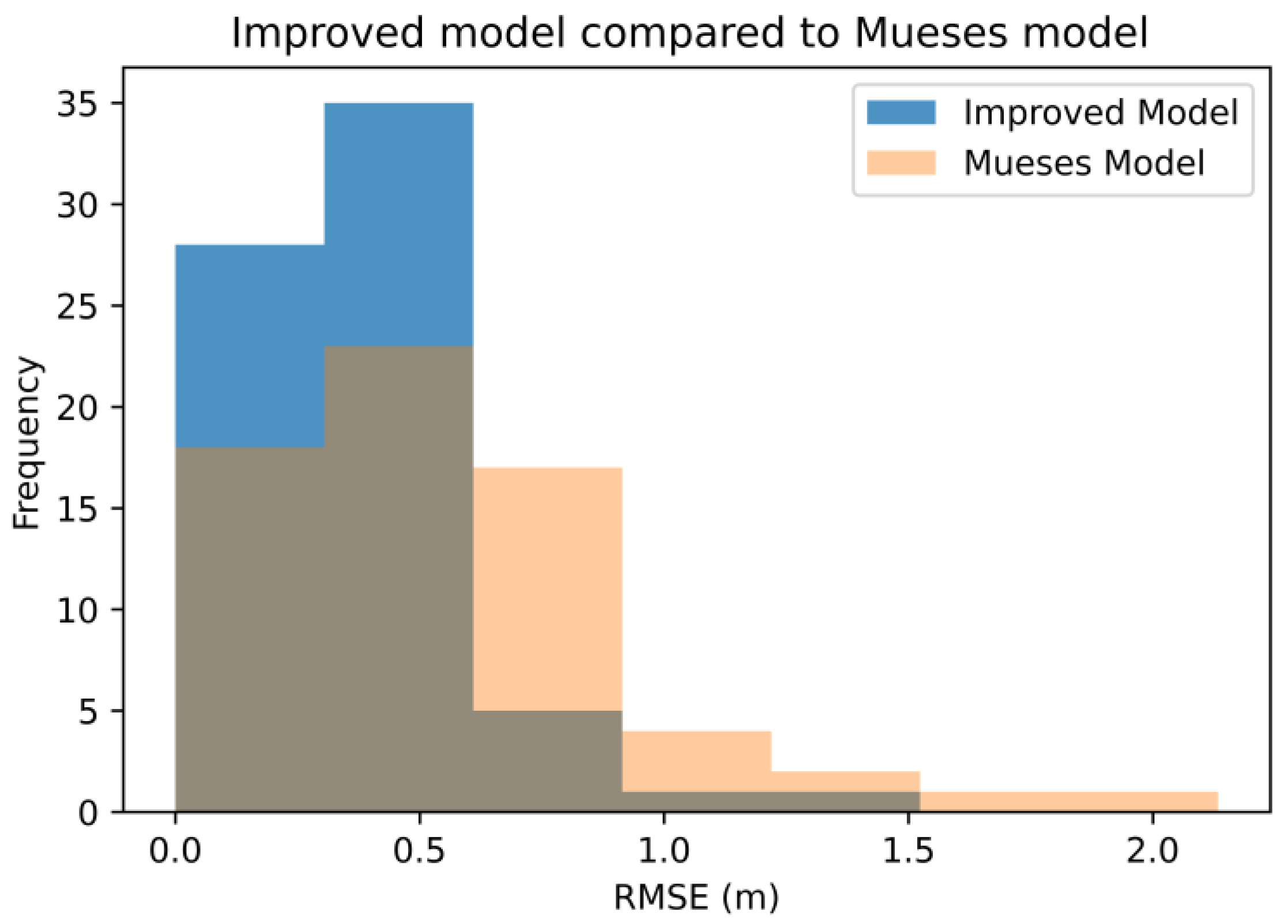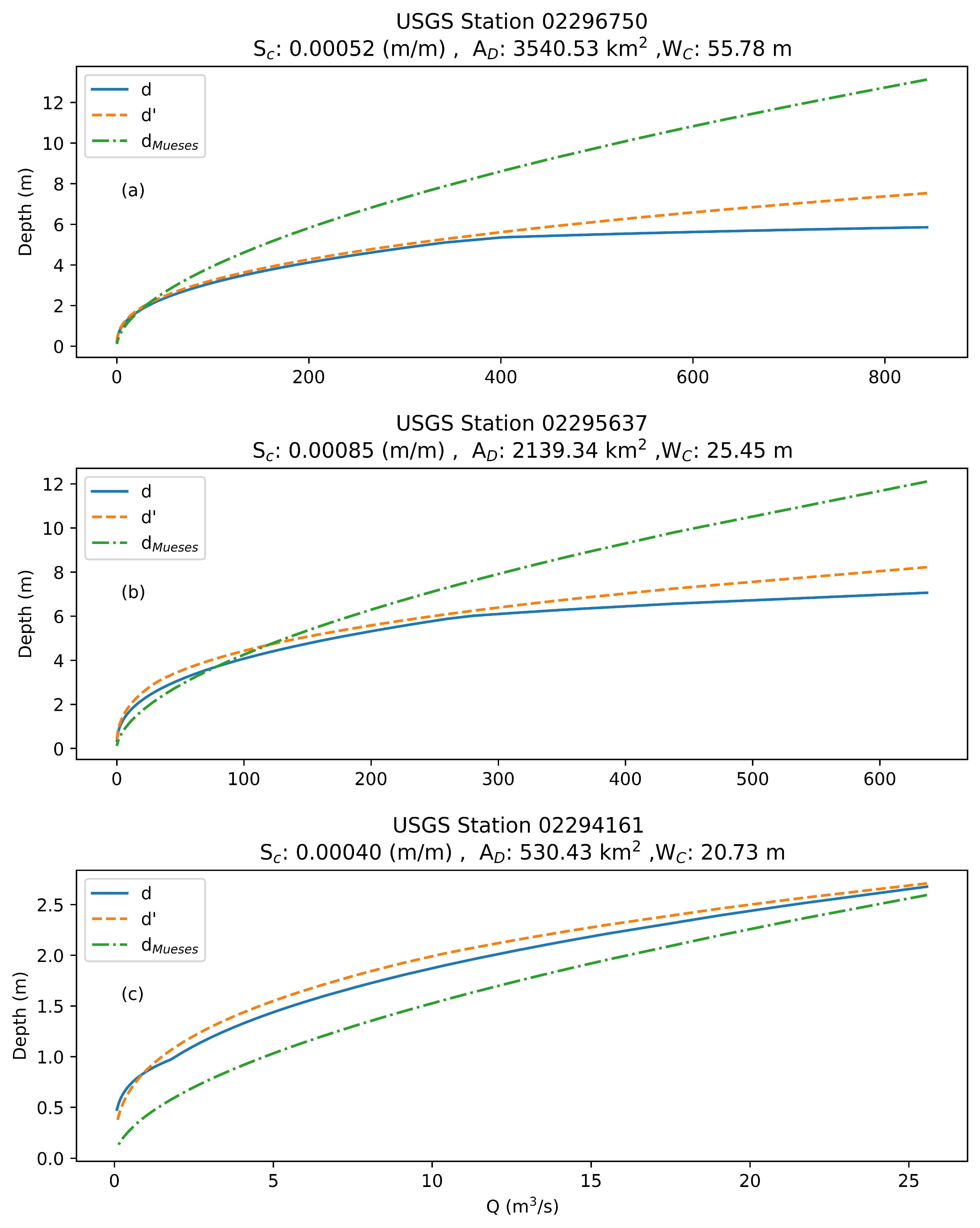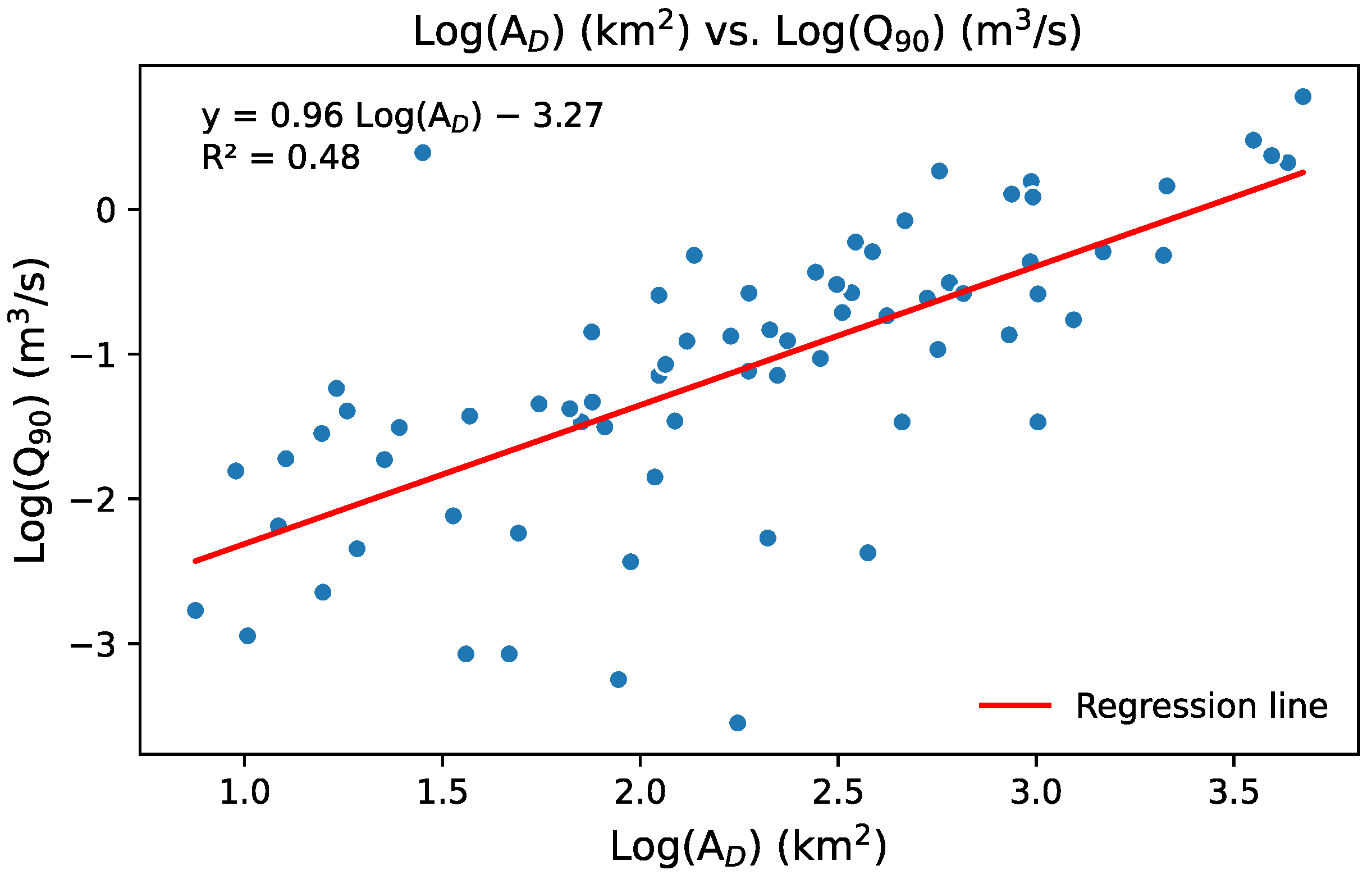1. Introduction
Managing water resources is challenging under the impacts of climate change and the ever-increasing demand from global population growth, which also leads to increased urbanization [
1]. Managing water resources depends on quantifying the available water resources and understanding the impacts of these and other stresses. In many cases, decisions concerning the best water management practice require using hydrologic simulation models [
2]. Hydrologic simulation models simplify complex real-world hydrology and estimate the hydrologic responses to alternative water resource management actions. These models can be used for extended periods of continuous simulation (years) or evaluating single storm event responses [
3]. The objective of developing hydrologic models can be to assess changes in streamflow due to changes to input stresses (e.g., climate variability, land use change, diversion options, mining effects, and stream–aquifer interaction from pumping stresses) to provide decision makers with the knowledge that enables better water resources management [
4]. Hydrologic models are conceptualized based on the model objectives (questions asked) and available budgets [
5].
Streamflow discharge is the quantity of water transported through a channel during a specific time, and the stage is the water surface height in a waterbody above a known datum [
3]. A depth–discharge relationship or discharge rating is a relationship between the flow rate and stream stage or water depth at a channel outlet [
6]. Within a hydrologic model, a discharge rating is required at the outlet of each simulation unit representing a portion of an alluvial wetland/stream system [
7]. For example, combined input of stage–discharge storage tabulated discharge rating is required for popular hydrologic models such as HSPF [
8] and SWMM [
9], as well as many others.
The hydrologic response within a model is very sensitive to discharge rating relationships, and these data are time-consuming for modelers to develop. The discharge rating depends on channel geometry, stream slope, vegetation, roughness coefficient, sediment load, and bank stability [
10]. Intensive GIS and manual (spreadsheet) data manipulation is required to construct discharge ratings for a model domain. This is especially problematic when the outlets of most stream reaches (i.e., model simulation units) do not have measured cross-sections, discharge ratings, or continuous discharge records. Moreover, the required work becomes daunting when hydrologic models are required for large areas with extensive alluvial stream and wetland systems.
In most applications, the available data to develop discharge ratings include GIS coverages and a few U.S. Geological Survey (USGS) streamflow gauging stations. The available stage–discharge data most likely originate from USGS stage gauging stations [
11]. Generally, USGS stage–discharge rating curves are available at established USGS streamflow measurement stations. However, they are relative to fixed local or National Geodetic Vertical Datum of 1929 (NGVD 29) or North American Vertical Datum of 1988 (NAVD 88) datums and can shift over time [
12]. These local or fixed datum stage–discharge rating relationships must be converted to depth–discharge ratings, considered more fixed over time. However, these data only represent one stream cross-section and do little to help populate discharge ratings when a large regional model may possess several hundred or thousands of stream sections that all require discharge ratings [
4].
The standard approach to developing a stream’s stage–discharge relationship or discharge rating is to visit the field several times to measure the flow for different stages, covering a series of low-to-high flows [
13]. These observations are then used to develop a curve that can convert the continuous stream-stage measurements to discharge estimates [
13]. Normally, to build a measured stage–discharge relationship in natural streams, observed stages must be plotted against the observed discharges [
14]. Alternatively, empirical methods to build discharge ratings can be used, such as assuming the streamflow is in uniform open channel flow with a prismatic channel section and then using Manning’s or similar equations to predict or calculate flow estimates [
3]. These empirical methods require measured or estimated channel properties such as the cross-section area, slope, and subjectively interpreted roughness coefficients [
4,
13,
15]. Channel properties are seldom available online or from GIS databases. They are expensive and time-consuming to obtain, especially for larger regional assessments with hundreds to thousands of stream sections that must be parameterized with discharge rating tables.
Depth–discharge relationships are more consistent than stage–discharge in live beds and vegetated natural sections [
6]. They are thus more useful input for the discharge rating of alluvial stream/wetland systems [
6]. This study sought to develop a method to characterize the depth–discharge relationship for alluvial channels by using readily available GIS data, building on the work of Mueses et al. [
6], Lewelling [
16], Emmet [
17], and Leopold [
18].
As pointed out in the discussion above, discharge rating curves of natural streams tied to a fixed datum are not fixed; they shift over time. The changes in the live-bed channels and floodplains over time result in shifting discharge ratings in natural streams [
19]. Vegetation changes, fallen trees, live (variable) bed materials, and anthropogenic activities cause discharge rating curves to shift up or down over time. As a result, discharge rating data tied to the stage will not have a fixed singular one-to-one relationship, and a particular discharge threshold may be experienced for many different stages. Hydrologic models generally require a fixed time, one-to-one (depth–discharge pairs) discharge rating as an input. Mueses et al. [
6] developed a simple model to produce an approximated fixed discharge rating curve using readily available GIS data. Mueses et al. [
6] used 35 streamflow stations in southwest Florida to reproduce depth–discharge curves by normalizing the daily discharge and depth using the 10% discharge exceedance (
Q10), the corresponding depth (
d10), and a power law exponent (
mMueses) to describe rating curve behavior.
In the expected application of the Mueses et al. [
6] approach,
Q10,
d10, and
mMueses (exponent) values would be derived from GIS data, and the exponents would be found from nearby gauge settings or using average fitted exponents. Using the drainage area to predict
Q10 proved to be an efficient approach for predicting that variable. However, it was noted that there would be uncertain outcomes in other areas, and deriving
Q10 relationships could be regionally or locally dependent. However, searching for a simplistic method to predict
d10 using a similar analysis was not as productive. A method based on the square root of drainage area was hypothesized and tested but resulted in high errors and pore R
2 (R
2 ≤ 0.6) in depth prediction. There was another dilemma: how best to estimate the
mMueses exponent for ungauged sections? When analyzing gauged sites, each site was found to have a different exponent. It is suspected that each site (and thus each reach) possesses a different exponent based on the impact of the channel’s shape, friction, and slope on the discharge rating behavior.
Lewelling [
16] discussed one of the fundamentals of streamflow behavior that should be considered in this approach: discharge rating behavior is different for in-channel stages than out-of-bank flows. Generally, flows greater than 10% exceedance flows (less than 10% exceedance) begin to approach out-of-bank flows (flood stage). In comparison, the majority of the discharges (greater than 10% exceedance) are contained within the channel bank in natural and man-made sections [
16]. In addition, Leopold et al. [
18] introduced the idea of normalizing the depth and discharge using the bankfull values to create a regional dimensionless depth–discharge relationship for ungauged locations. According to Mueses et al. [
6], when their approach was compared to USGS observations, the results generally presented only small errors for intermediate and low discharges, with generally larger errors reserved for high (and presumably more out-of-bank) discharges.
It is well-recognized that natural channels exhibit different flow behavior (control) with characteristically different frictional conditions and geometries for in-bank and out-of-bank flows [
18]. Thus, each control phase would exhibit different discharge rating behavior, especially the transition from channel control to floodplain control. Therefore, using a single exponent (
mMueses-value) to reproduce the depth–discharge curve for low and extreme discharges may be expected to yield relatively higher errors for extreme discharges, which was the hypothesized reason for the relatively high errors in larger flows in Mueses et al. [
6].
Alluvial wetlands are those floodplain-type wetlands that encompass (surround) the main channel (thalweg), the storage of which greatly affects the out-of-bank flows through storage attenuation and differing floodplain frictional conditions [
20]. Alluvial wetlands, therefore, have incised channels representing the main thalweg and/or subchannels or branches in a dendritic stream system [
21]. These wetland channels are formed naturally and are in relation (proportion) to the dominant discharges strongly controlled by the cumulative drainage area, upland, and climatologic factors (e.g., soil types and mean annual rainfall). Thus, the channel size naturally increases with the high flow discharge index (e.g.,
Q10) [
17]. Consequently, natural streams seem to achieve a balance between the channel geometry and the conveyance of the periodic but infrequent larger flows experienced in the channel [
3].
Lawlor [
22] investigated the relationship between the bankfull discharge, drainage area, and channel morphology to estimate the bankfull discharge at ungauged stations. The results showed that relating the drainage area to channel morphologic characteristics and the drainage area to the bankfull discharge using regression analysis can be useful to approximate channel morphology and/or bankfull discharge [
22]. Based on the findings of [
17,
23], the size of the drainage area within the same region can be reliably used to determine the bankfull channel discharge, bankfull mean depth, bankfull width, and bankfull cross-section area.
As pointed out previously, the only way to build a depth–discharge relationship in natural streams is by plotting computed depths vs. observed discharges [
14]. Plotting the depths against discharges on arithmetic paper over a single control phase or section yields a parabolic line, while plotting them via log–log paper or relations produces a straight line with a constant slope [
14]. Plotting a long period of depths and discharges in log–log relations yields straight lines with similar slopes but different offsets that enable hydrologists to dictate the change in control sections, and especially the transition from in-channel control to floodplain control, which is, by definition, beyond bankfull discharge.
The bankfull discharge of an incised channel is the dominant discharge controlling the evolution of the channel geomorphology. Bankfull flow is defined as the channel discharge rate just before the streamflow starts to overflow into floodplain wetlands [
18]. Periodic bankfull discharge dictates the channel’s shape, size and invert and thus the depth model [
14]. In field measurements, the bankfull depth can often be recognized from stain lines or scour marks and thus measured from the channel bed, vegetation boundaries, transitions between the bed and bank materials, and/or sudden fluctuations on side slopes between channels and floodplains [
14]. As a result, the bankfull depth measurement is frequently subjectively interpreted or opinion-based and thus prone to error [
14].
The studies on bankfull discharge estimation using reoccurrence interval, which is the exceedance probability of a bankfull discharge in a given year, are inconsistent. Lawlor [
22] found that the bankfull discharge reoccurrence interval is between 1 year and 4.4 years, with a median of a 1.5-year recurrence threshold overall. Further supporting this threshold, previous studies showed that the recurrence interval was approximately 1.5-year exceedance [
24,
25,
26,
27,
28]. However, based on another study by Parrett and Johnson [
29], the bankfull discharge at ungauged stations could be calculated through regression of the bankfull discharge to the two-year reoccurrence interval peak discharge. According to Lawlor [
22] and previous studies, using a 1.5-year reoccurrence interval to calculate the bankfull discharge for ungauged stations might yield better estimates than the 2-year exceedance threshold. In addition, Mueses et al. [
6] sought to develop a non-dimensional discharge rating model by normalizing with respect to bankfull discharge and depth; however, challenges in predicting the bankfull discharge and depth based on the drainage area rendered this approach unviable.
The main goal of this study was to develop a generic model and parameter guideline to produce discharge rating curves for vast ungauged alluvial wetland networks within a continuous hydrologic simulation model. The model seeks to present procedures and parameters for both in-channel and out-of-bank rating. This approach reduces the need for extensive field surveys. It requires only sufficiently resolved Digital Elevation Model(s) (DEMs); commonly available, delineated basins; and cumulative drainage areas. This method enables modelers to establish depth–discharge relationships for any area without direct gauge data, offering a cost-effective and adaptable solution for expansive terrains.
4. Discussion, Recommendations, and Limitations
This study’s objective was to develop a more reliable method to characterize the depth–discharge relationship for ungauged alluvial stream/wetland systems. Using commonly available GIS data and simple relationships, the method has been tested for southwest Florida hydrology and demonstrated improved performance compared to the earlier procedures presented by Mueses et al. [
6]. The method uses minimal calibration parameters and can be used or adapted for other environments. Since the drainage area size is the most important variable and previous studies indicated much lower sensitivity to other variables such as upland land use and watershed slope, it is believed that this variable, together with a GIS determination of longitudinal channel slope and transverse width, can be used to estimate the important controlling factors of
A10,
d10,
Q10, and in-bank and out-of-bank discharge rating exponents,
m1 and
m2, for applications where measured cross-sections and discharge rating conditions are sparse.
Providing separate exponents for in-bank and out-of-bank discharge ratings greatly increases the accuracy and physical basis of the approach. However, for ungauged sections, doubling the number of uncertain parameters would lead to overparameterization if an objective means to define both were unavailable. This approach indicated that adding another flow index, Q50, could be used to help predict the in-bank flow exponent, m1. Since Q50 was found to be strongly correlated to drainage area and, by definition, represents the median flow behavior, it was shown to suitably provide for the determination of the low-flow (in-bank) discharges and the appropriate exponent, m1.
For higher flows, Q1 was also shown to be strongly correlated to the drainage area, and this flow represents a likely out-of-bank or near-bankfull flow condition. This flow index has a lower probability of occurrence and is observed for approximately only 3 days per year on average. Since it is appropriate for high flows and for convenience, it was selected to provide a method to estimate the high-flow behavior, m2, and showed acceptable predictive performance. However, where data exist for out-bank behavior, discharge exceedances with extremely low probability, such as the 0.01 percentile conditions, can be utilized. It should be noted that these percentile exceedances refer to daily, rather than yearly, occurrences.
Not surprisingly, the 90-percentile exceedance discharge was not suitably dependent on the drainage area (
Figure 12), perhaps due to the strong sensitivity to baseflow and groundwater processes, and thus provided an index that was not useful for this method. Furthermore, natural streams experience live bed processes, shifting bed materials, and sensitivity to fallen debris, making the discharge rating curve behavior for low flows unreliable or even unstable. As a result,
Q50 is believed to be the lowest index that is suitable for describing the medium- and low-flow discharge rating behavior.
The southwest Florida region is mostly characterized as a low-slope environment (generally <0.3%) with protected alluvial floodplain wetlands, where natural streams tend toward uniform flow more often than higher-gradient systems. This may be one reason the concept of a fixed and predictable discharge rating behavior prevails and seems appropriate.
Relating the drainage area to depth assumes that when the drainage area is increasing, the depth is also, which is not always the case considering channel width variability. However, switching to a cross-sectional area dependence (A10), assuming that the cross-sectional area is directly related to the magnitude of Q10, is conceptually sound and has been shown to be a better basis for defining d10. Hence, GIS procedures or other interpretations will be needed to define the hydraulic (or top-of-bank) width for Q10.
The primary limitation of this study is that the empirical relationships may differ in other environmental settings, particularly in highly variable alluvial systems (e.g., anthropogenetic and hardened channel settings). This is because it can be challenging to ascertain whether channels in such settings are fully developed and contain any relation to flow return probability (index). The difficulty lies in determining if these channels have evolved between regular flow states and the erosion susceptibility of channel morphology. In sandy-terrain Florida, channels are highly variable in degree of incision, some deeply incised, others not, but are in relative dynamic equilibrium with probabilistic flows and cross-section relation, leading to a strong relationship between drainage area and cross-sectional area. This would likely not be the case in artificially hardened or natural rock-bed channels in non-depositional environments. However, even with different soil types, land use, and hydrology in coastal plain environments, these empirical relationships will likely still be applicable, but some local adjustments to the coefficients may be necessary. To apply this methodology in a new environment, it will be essential to have a sufficient number of gauge stations with extensive records of in-bank and out-of-bank discharges to validate the approach and coefficient behavior. Additionally, observational verification of the method in different settings may prove to indicate yet another variable or process that becomes important. In the absence of a sufficiently resolved DEM, channel width and slope must be manually determined from topographic data or estimated by the user.
5. Conclusions
This study sought to develop a more reliable method for characterizing the depth–discharge relationship in dendritic alluvial stream/wetland systems for hydrologic modeling where limited or sparse gauge or survey data are available. The method uses simple GIS and normalized analyses based on derivable flow indexes defined for each channel section. The improved procedure simply requires cumulative drainage area, local channel slope, channel width, and readily derivable GIS data to develop discharge ratings for gauged and ungauged sections. The discharge rating curves for 70 USGS streamflow gauges were reproduced using the procedure, and then the produced and observed discharge rating curves were compared to evaluate the accuracy of the method. The methodology developed demonstrated improved performance compared to previous methods with minimal calibration parameters.
The comparison showed robust performance in predicting depth with minimal errors. In the analysis of streamflow depth predictions, the average RMSE was 0.38 m (≈1.24 ft), with an interquartile range between 0.21 m and 0.49 m. The ME showed no bias (centered around 0 m), with manageable interquartile values ranging +/−0.24 m.
The approach relied heavily on the cumulative drainage area to each reach (AD), which was found to be the most significant variable. By combining GIS-determined channel slopes (Sc) and width (WC), as well as key flow and depth indexes of d10, d50, and d1, and Q10, Q50, and Q1, discharge rating exponents m1 and m2 can be estimated, which were shown to be reliable for predicting in-bank and flood flow (out-of-bank) discharge ratings. This study found strong relationships between Q50 and AD for low-flow discharges and between Q1 and AD for high flows, aiding in estimating the respective exponents m1 and m2.
The success of the approach in the studied Florida region, characterized by similar vegetation and slopes in fully developed (depositional equilibrium) floodplain wetlands, suggests potential applicability in other coastal plain environments. Adjustments may be necessary in different environmental settings, particularly where channels have high variability or are not in full depositional equilibrium. However, success and confidence in other settings will require sufficient gauging stations and adequate GIS data before validating the approach.
